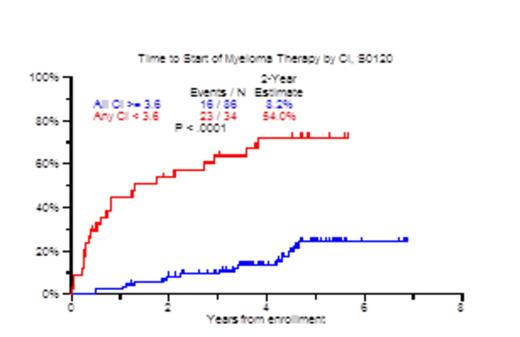Abstract
Progression of Asymptomatic Monoclonal Gammopathies to Myeloma requiring treatment -Clinical Multiple Myeloma (CMM)- is an important issue in current clinical investigation toward secondary prevention, i.e. treating high-risk AMG. Several predictive models have been published, including one that incorporated gene expression profiling (GEP) of plasma cells (PC) where a GEP70 score ≥0.26 was linked to higher AMG-CMM progression in a multivariate model (Dhodapkar, Blood 2014). We have applied 2-parameter flow cytometry of DNA and cytoplasmic immunoglobulin (FDC) of bone marrow aspirates as part of baseline staging of all patients with plasma cell dyscrasia. A modification introduced in August 2006 on the doublet discrimination method increased accuracy and reproducibility of FDC results considerably and allowed for the detection of a plasma cell population with a low CI<2.8 as an independent predictor of PFS and OS in newly studies of newly diagnosed CMM treated with TT3b even in the context of GEP70 risk (Papanikolaou, ASH 2012). Realizing the importance of the FDC derived CI in CMM, we assessed whether FDC data from the observational AMG protocol S0120 could identify a population of patients with a high risk for progression to CMM. Out of 252 eligible patients, 130 had an FDC sample taken within 30 days prior to enrollment date and analyzed under the modified doublet discrimination method. FDC identified a light chain restricted population (LCR) in 121 patients. The number of distinct DNA stem lines in the flow cytometry assay, the percentage of LCR plasma cells (LCR%), their ploidy status and respective CI, were evaluated alone and in relation with clinical, laboratory and genetic parameters known to affect progression of AMG to CMM. For continuous FDC variables, the running log-rank statistics were used to determine the optimal cut-off points. In univariate analysis, the existence of at least two distinct DNA stem lines (HR: 3.3, P=0.002), a FDC LCR population of plasma cells >17% (HR: 6.76, P<0.001) and the presence of a LCR population with a CI<3.6 (HR: 6.42, P<0.001) (Figure 1) were statistically significant along with other clinical factors of established prognostic value. A M component> 3g/dL (HR: 12.5, P<0.001), an involved light chain level >10mg/dL (HR: 2.8, P=0.019), a GEP70 score ≥0.26 (HR: 8.22, P<0.001) and the presence of a LCR population with a CI < 3.6 (HR:4.15, P=0.002) survived in the multivariate analysis. To further confirm importance of a low CI to CMM progression, we compared the CI of S0120 with the TT3b patients. The CI was significantly lower in TT3b cases regardless of when the comparison was made for all patients or for strictly aneuploidy cases (P<0.0001) to exclude the possibility that the CI difference reflects the lower percentage of normal plasma cells found in CMM.
In conclusion, FDC is an easily applicable, fast and low-cost test, which offers valuable prognostic information even in the era of gene expression profiling and other cytogenetic testing strategies. The identification of a low CI as a risk factor suggests that, progression of AMG to CMM is characterized by the emergence of a low immunoglobulin producing myeloma cell population.
Time to progression requiring myeloma therapy by CI, S0120
Time to progression requiring myeloma therapy by CI, S0120
Heuck:Celgene: Honoraria; Foundation Medicine: Honoraria; Millennium: Membership on an entity's Board of Directors or advisory committees; Janssen: Membership on an entity's Board of Directors or advisory committees. Dhodapkar:Celgene: Research Funding. Zangari:Norvartis: Membership on an entity's Board of Directors or advisory committees; Onyx: Research Funding; Millennium: Research Funding. Morgan:Celgene Corp: Membership on an entity's Board of Directors or advisory committees; Novartis: Membership on an entity's Board of Directors or advisory committees; Janssen: Membership on an entity's Board of Directors or advisory committees; Myeloma UK: Membership on an entity's Board of Directors or advisory committees; International Myeloma Foundation: Membership on an entity's Board of Directors or advisory committees; The Binding Site: Membership on an entity's Board of Directors or advisory committees; MMRF: Membership on an entity's Board of Directors or advisory committees.
Author notes
Asterisk with author names denotes non-ASH members.


This feature is available to Subscribers Only
Sign In or Create an Account Close Modal